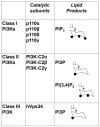Phosphoinositide 3-Kinase-Dependent Signalling Pathways in Cutaneous Squamous Cell Carcinomas
- PMID: 28696382
- PMCID: PMC5532622
- DOI: 10.3390/cancers9070086
Phosphoinositide 3-Kinase-Dependent Signalling Pathways in Cutaneous Squamous Cell Carcinomas
Abstract
Cutaneous squamous cell carcinoma (cSCC) derives from keratinocytes in the epidermis and accounts for 15-20% of all cutaneous malignancies. Although it is usually curable by surgery, 5% of these tumours metastasise leading to poor prognosis mostly because of a lack of therapies and validated biomarkers. As the incidence rate is rising worldwide it has become increasingly important to better understand the mechanisms involved in cSCC development and progression in order to develop therapeutic strategies. Here we discuss some of the evidence indicating that activation of phosphoinositide 3-kinases (PI3Ks)-dependent signalling pathways (in particular the PI3Ks targets Akt and mTOR) has a key role in cSCC. We further discuss available data suggesting that inhibition of these pathways can be beneficial to counteract the disease. With the growing number of different inhibitors currently available, it would be important to further investigate the specific contribution of distinct components of the PI3Ks/Akt/mTOR pathways in order to identify the most promising molecular targets and the best strategy to inhibit cSCC.
Keywords: Akt; PI3K; cutaneous squamous cell carcinoma; mTOR.
Conflict of interest statement
The authors declare no conflict of interest. The funding sponsors had no role in the design of the study; in the collection, analyses, or interpretation of data; in the writing of the manuscript, and in the decision to publish the results.
Figures



Similar articles
-
Growth and Viability of Cutaneous Squamous Cell Carcinoma Cell Lines Display Different Sensitivities to Isoform-Specific Phosphoinositide 3-Kinase Inhibitors.Int J Mol Sci. 2021 Mar 30;22(7):3567. doi: 10.3390/ijms22073567. Int J Mol Sci. 2021. PMID: 33808215 Free PMC article.
-
Immunohistochemical expression of selected phosphoproteins of the mTOR signalling pathway in canine cutaneous squamous cell carcinoma.Vet J. 2019 Mar;245:41-48. doi: 10.1016/j.tvjl.2018.12.024. Epub 2019 Jan 3. Vet J. 2019. PMID: 30819424
-
Dysregulated Expression of Phosphorylated Epidermal Growth Factor Receptor and Phosphatase and Tensin Homologue in Canine Cutaneous Papillomas and Squamous Cell Carcinomas.J Comp Pathol. 2020 Jan;174:26-33. doi: 10.1016/j.jcpa.2019.10.005. Epub 2019 Nov 26. J Comp Pathol. 2020. PMID: 31955800
-
Targeting the phosphatidylinositol 3-kinase (PI3K)/AKT/mammalian target of rapamycin (mTOR) pathway: an emerging treatment strategy for squamous cell lung carcinoma.Cancer Treat Rev. 2014 Sep;40(8):980-9. doi: 10.1016/j.ctrv.2014.06.006. Epub 2014 Jul 3. Cancer Treat Rev. 2014. PMID: 25037117 Review.
-
A tEMTing target? Clinical and experimental evidence for epithelial-mesenchymal transition in the progression of cutaneous squamous cell carcinoma (a scoping systematic review).Discov Oncol. 2022 Jun 6;13(1):42. doi: 10.1007/s12672-022-00510-4. Discov Oncol. 2022. PMID: 35666359 Free PMC article.
Cited by
-
circ_0001821 Contributes to the Development of Cutaneous Squamous Cell Carcinoma by Regulating MicroRNA-148a-3p/EGFR Axis and Activating Phosphatidylinositol 3-Kinase/Akt Pathway.Mol Cell Biol. 2022 Mar 17;42(3):e0008921. doi: 10.1128/MCB.00089-21. Epub 2022 Feb 22. Mol Cell Biol. 2022. PMID: 35191745 Free PMC article.
-
High-throughput lipidomic profiles sampled with electroporation-based biopsy differentiate healthy skin, cutaneous squamous cell carcinoma, and basal cell carcinoma.Skin Res Technol. 2024 May;30(5):e13706. doi: 10.1111/srt.13706. Skin Res Technol. 2024. PMID: 38721854 Free PMC article.
-
Growth and Viability of Cutaneous Squamous Cell Carcinoma Cell Lines Display Different Sensitivities to Isoform-Specific Phosphoinositide 3-Kinase Inhibitors.Int J Mol Sci. 2021 Mar 30;22(7):3567. doi: 10.3390/ijms22073567. Int J Mol Sci. 2021. PMID: 33808215 Free PMC article.
-
Obesity-induced immunological effects on the skin.Skin Health Dis. 2023 Feb 28;3(3):e160. doi: 10.1002/ski2.160. eCollection 2023 Jun. Skin Health Dis. 2023. PMID: 37275420 Free PMC article. Review.
-
PIK Your Poison: The Effects of Combining PI3K and CDK Inhibitors against Metastatic Cutaneous Squamous Cell Carcinoma In Vitro.Cancers (Basel). 2024 Jan 15;16(2):370. doi: 10.3390/cancers16020370. Cancers (Basel). 2024. PMID: 38254859 Free PMC article.
References
-
- Skin Cancer Incidence Statistics. [(accessed on 4 July 2017)]; Available online: http://www.cancerresearchuk.org/health-professional/cancer-statistics/st....
Publication types
LinkOut - more resources
Full Text Sources
Other Literature Sources
Research Materials
Miscellaneous

